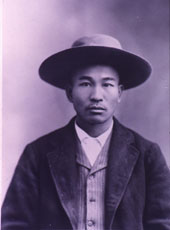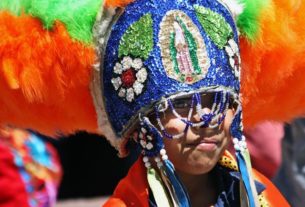Mexico is an ethnically diverse country. To understand Méxio, one must understand her peoples, their history and contributions to what is the México of today. Within this section, we consider those who lived here prior to the 14th century as Indigenous Peoples – Toltec, Olmeca, Zapotec, Maya, Aztec, Huichol, Purepecha, Tarahumara, and many more. Those who arrived with the Spanish Conquest and later we identify as Immigration Peoples.
Mexico celebrates the history of its founding peoples. Some of the earlier civilizations are now thought to be the oldest in the world. Some of the archeological sites pre-date those found in Egypt. Some of the technologies used also predate those found elsewhere.
Indigenous Mexico – An Overview – By John P. Schmal
The Maya make up the largest homogenous group of Indians north of Peru, inhabiting a vast area that encompasses Mexico’s Yucatan peninsula and parts of the states of Tabasco and Chiapas, as well as Guatemala, Belize and parts of western Honduras and El Salvador.
While not the earliest of the great Mesoamerican civilizations, the Maya are generally considered the most brilliant of all the Classic groups. The culture’s beginnings have been traced back to 1500 BC, entering the Classic period about 300 AD and flourishing between 600 and 900 AD.
The Huichol are a hearty and enduring people numbering about 18,000, most of which live in the Jalisco and Nayarit, two rugged and mountainous states in North Central Mexico.

They are descendants of the Aztecs and are related to their Uto-Aztecan speaking cousin, the Hopi of Arizona. They are representatives of a pre-Columbian shamanic tradition which is still functioning according to the ceremonies of their remote past. Having withstood the Spanish Invasion, they are still striving to keep their culture alive and viable, despite the ever increasing physical and cultural encroachment of their Mexican neighbors.
Oaxaca’s rugged topography has played a significant role in giving rise to its amazing cultural diversity. Because individual towns and tribal groups lived in isolation from each other for long periods of time, the subsequent seclusion allowed sixteen ethnolinguistic groups to maintain their individual languages, customs and ancestral traditions intact well into the colonial era and – to some extent – to the present day. For this reason, Oaxaca is – by and large – the most ethnically complex of Mexico’s thirty-one states. The Zapotec (347,000 people) and the Mixtec (241,000 people) are the two largest groups of Indians, but they make up only two parts of the big puzzle.

Millions of Americans today look to the Mexican state of Zacatecas as their ancestral homeland. But it is very difficult to locate historical information on Zacatecas in the English language media. As a result, many Zacatecanos know little or nothing about the region in which their ancestors lived for thousands of years.
Jalisco is La Madre Patria (the Mother Country) for millions of Mexican Americans. Given this fact, it makes sense that many sons and daughters of Jalisco are curious about the cultural and linguistic roots of their indigenous ancestors. The modern state of Jalisco consists of 31,152 square miles (80,684 square kilometers) located in the west central portion of the Mexican Republic. However, the Jalisco of colonial Mexico was not an individual political entity but part of the Spanish province of Nueva Galicia, which embraced some 180,000 kilometers ranging from the Pacific Ocean to the foothills of the Sierra Madre Occidental.
Several million Americans look to the northern Mexican state of Chihuahua as their ancestral homeland. An understanding of Chihuahua’s indigenous inhabitants from the pre-Hispanic era to the Nineteenth Century requires an imagination that dispenses with national borders.
Immigration
When one thinks of foreign influence within Mexico due to immigration, Spain is the first country that comes to mind. However, Mexico’s cultural and ethnic fabric is woven with other foreign ethnic groups that have each contributed to the tapistry that is Mexico.
This Feature Section is devoted to exploring some of these other, lesser known, ethnic groups: where they came from; how they contributed to their new country; and what presence they have in today’s modern Mexico.

Just as the Chinese contributed to the development of the west in both Canada and the USA, Chinese immigration to Mexico at the turn of the 20th century contributed significantly to the development of irrigation in the Mexicali area. Joe Cummings’ article ” Sweet and Sour Times on the Border ” traces the Chinese immigration and experience in Mexico.
Afro-Mexican
By 1650, more than 150,000 blacks and mulattoes lived in Mexico, a figure that actually surpassed Spanish immigration. In fact, blacks outnumbered Spaniards in Mexico until after 1810. The Afro-Mexican presence is not widely known. Yet Blacks in Mexico have a long history here, and in both the east coast, (Veracruz) and the west Coast (Costa Chica) there are thriving communities. In Bobby Vaughn’s Black Mexico, we explore the Costa Chica.
With Roberto Rodriguez and Patrisia Gonzales’ ” African Roots Stretch Deep into Mexico “, we explore the still thriving African legacy in Mexico, where Mexicans play African “hand pianos” and perform “the dance of the black people.” Mexican “corridos” — or song-stories — tell of slave uprisings. And the marimbas of Mexico, as well as those of Central America and Ecuador, all have their origins in Africa.

Jews in Mexico, a struggle for survival (by Shep Lenchek)
The survival of Judaism in Mexico is a tale of tenacity and tolerance. The story starts in Spain with the “Conversos”, Jews who had converted to Christianity, always under duress, and begins in Mexico around 1530.
The combination of tenacity on the part of Jews, and tolerance by Mexicans, both official and as individuals, has permitted Judaism to put down deep roots. Mexican Jews still struggle today against inter-marriage and migration to the United States and Israel. They have taken positive steps to handle these problems and, barring a radical change in the attitude of Mexicans or their government, are here to stay.
Mennonites in Mexico: a Dutch heritage.
The Mexican government needed farmers to work on land previously owned by William Randolph Hearst, one of the many foreign landowners expelled from Mexico after the end of the Mexican revolution in 1921. The Mennonites agreed to purchase this land. In return they were freed from Mexico’s educational laws and military service. They were also promised a tax-free life in Mexico. A 2nd emigration wave from Canada to Mexico took place in the late 1940s when the Kleine Gemeine (small church) Mennonites, originally from Russia, settled in Mexico.




great historical knowledge
Hi, have you ever researched the Irish in Mexico? Many Irish fought in the rebellion/revolution. However, many came over much earlier with the Spanish, especially from central Ireland. This is an area of great interest to me. I have some background research if this is an area you are interested in exploring.
Hi Arlene, Thanks for commenting. Yes, we would certainly be interested in publishing a piece about the history of the Irish in Mexico. Please use this email to reach me directly. Thanks, TB.